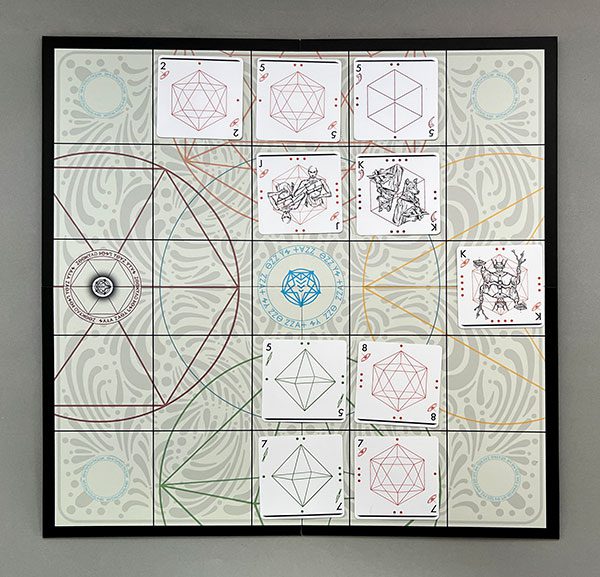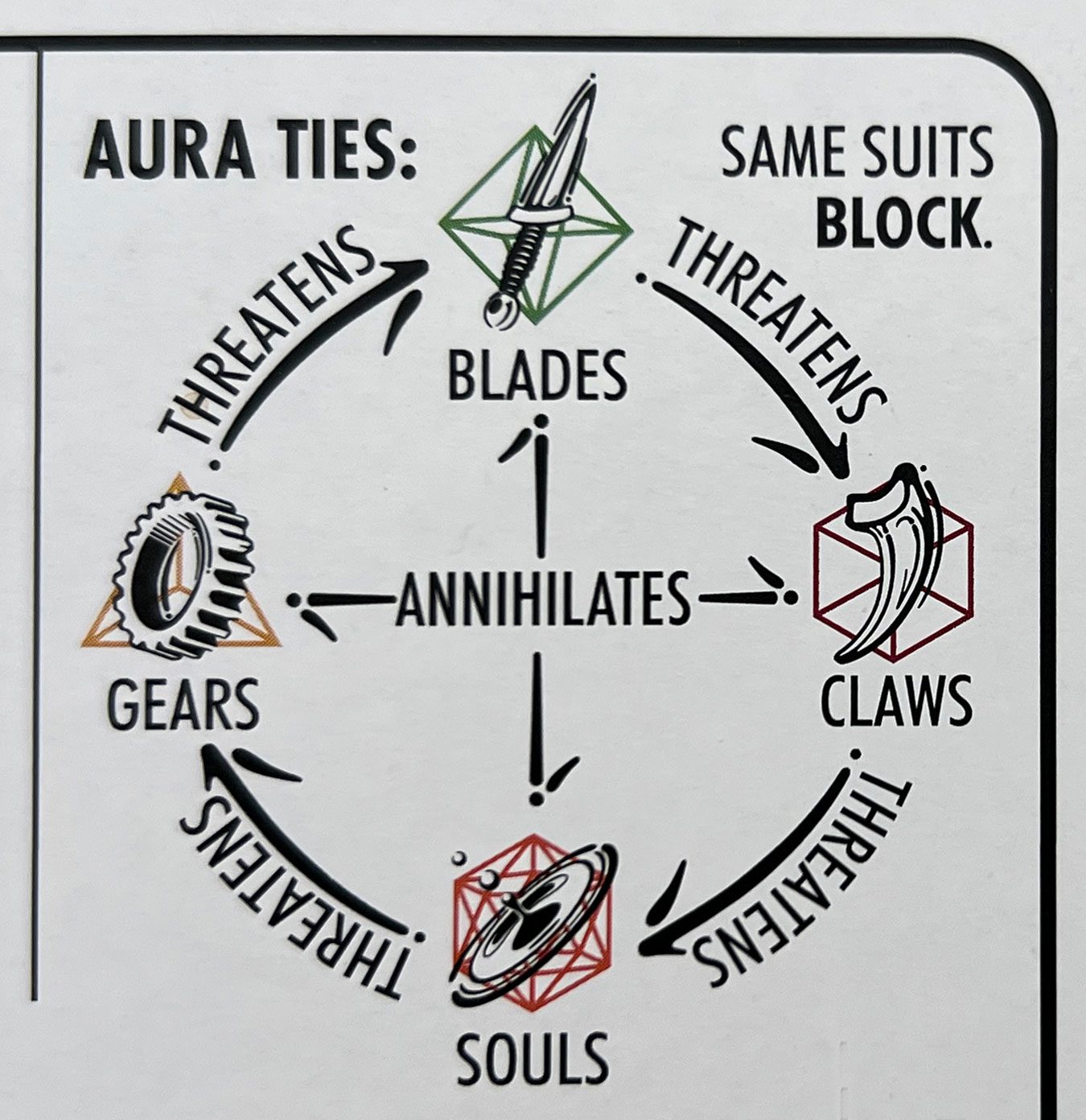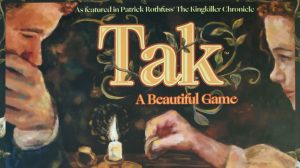When Anthromancer went live on Kickstarter in 2020, it described itself as: A Game. An Oracle. An Album. A Myth.
It would be understandable, then, if you asked, “What is Anthromancer?”
Anthromancer is the creation of Daniel Drake. It is both a board game and a tool for divining the unknown. And, if you like background music while you play games, Drake also released an album reflecting on a set of cards within the game.
I’m not so clear on the myth part.

As if that wasn’t enough, I’ll add that although BoardGameGeek.com recognizes the game within the Anthromancer box as Anthromancer, the game is referred to in the rules as Mercenarium.
Got all that? Good.
I’ll get back to the divination and musical aspects later. First, let’s look at the game.
The Game
Mercenarium is played on a 7×7 square board. Each side of the board has a center square known as a player’s House, or starting square. On your first turn, you’ll likely play a card from your hand into your House. From there, cards can be added to the board adjacent to one of your cards already on the board, providing they are either of the same suit or have the same value (an 8 of one suit can be placed next to an 8 of another suit), or have a consecutive face value (a 7 or a 9 of any suit can be placed next to an 8 of any suit).

The most common winning conditions are if you’re the first person to make five captures of your opponent’s cards or if you’ve cleared all your opponent’s cards from the board and occupy their Home square at the start of their turn.
You’ll start the game with five standard cards plus one special card. To understand how to play Mercenarium, you’ll need to understand the cards.
The deck of square cards come in four types:
- Standard deck cards from 2 through 10 in four suits
- Jack, Queen, King, and Ace cards in each suit, which are Mercenaries
- Lords, a special card, one in each suit
- Hymns, which are single-use, special power cards

The first three of these will each have important information on the sides. At the bottom of the card will be a solid line. When the card is placed on the board, this solid line must face the player placing the card to show ownership. The other three sides will have a series of stars, indicating the relative strength of the card in battle, with higher numbers defeating smaller numbers.

Ties are broken depending upon the two suits involved. Some suits will capture other suits (either the defender’s or the attacker’s card), while others will Annihilate one another resulting in both cards being removed from the game.

On a turn, you have several options:
- Play an appropriate card either into your empty Home space or next to a card in the field
- Move one of your cards on the board orthogonally from its starting position
- Capture an enemy card by moving your card (with a higher star count on the edge adjacent to the card being attacked) onto the enemy card’s space
- Draw a standard card from the deck
- Play a Hymn card from your hand and use its one-time ability
- Trade in the appropriate cards from your hand to acquire a new Hymn card (You may only have one Hymn in your hand at a time)
- Buy a Mercenary
This last action requires a bit of explaining. As you capture cards, you’ll be able to ‘spend’ one of them (by turning them over in front of you) to Buy a Mercenary. This means you’ll take control of an opponent’s Jack, Queen, King, or Ace on the board for at least one full round of turns. To do so, you’ll turn the card such that the solid line on the bottom of the card is facing you.
Captures ‘spent’ to Buy a Mercenary still count towards the five captures required for a win on captures.
A few special cards are worth pointing out:
Lords are cards that have no point value. They simply threaten the suit the Lord’s suit regularly threatens and is threatened by the suit the Lord’s suit is regularly threatened by. It’s also annihilated by the suit the Lord’s suit is regularly annihilated by.
There are two Hymn cards you can play on the board: The Fool and The Fox. When The Fool is played on the board, you’ll roll the six-sided Fool Die and place it on The Fool card. The Fool is then considered to have a strength along all three sides as the number rolled. Each time The Fool is moved, however, the Fool die is re-rolled and a new strength number is assigned to the card. When The Fox is played, the player takes the six-sided Fox die and places it on The Fox card with 1-4 on the upward face to indicate the corresponding suit, where it then acts as a Lord of the chosen suit. If the patterned die face is chosen, The Fox annihilates any card it overtakes.
A third Hymn, Zodiac, is placed in front of the player who plays it. The player then rolls the 12-sided Zodiac die. The resulting number will correspond to one of the Hymns and the player can use that Hymn’s power on that turn. Each turn, the player can choose to re-roll the Hymn die and claim the use of another Hymn’s power or, if they choose, save it for a later turn.
Thoughts About Mercenarium
The material in Anthromancer says Mercenarium can be played with 2-4 players. My first experience with the game was with three players and it simply did not work. The player in the middle was unintentionally ganged up on and the game was really only between the two players who faced one another.
That being said, Mercenarium is a solid game at two players. There is a fair amount of strategy in the game, between playing and moving cards on the board. You’ll quickly find that your five starting cards aren’t nearly enough and your Hymn likely isn’t all that helpful yet. The board is small enough that you’ll run out of maneuvering room (I can’t imagine a four-player game working well, either) with an unavoidable capture looming.
The Mercenary cards (Jack, Queen, King, and Ace) are the most powerful cards, each with high strength counts along their edges, but trading in a capture to turn that Mercenary card to your use means fortunes can change quickly.
And when a Hymn does come into play, it can also change the course of the game, either in subtle or very apparent ways.

The presentation and production values are top-notch. The rules for Mercenarium come as part of the hardback Codex, as well as a stand-alone Quick Guide. The Quick Reference cards do a great job of summarizing the rules, the suits, and each of the Hymns. The square cards are a good card stock and the dice come in a silk-screened Anthromancer bag.
All in all, Mercenarium is an intriguing game with considerable replayability.
Thoughts About Anthromancer
If you thought I was being a bit vague about some of the names and aspects of Mercenarium, you were right. I suspect between the game and the soundtrack, Daniel Drake was trying to create not just a game, but an Anthromancer Realm, a Sphere of Anthromancer Influence, as it were.
Or, perhaps The Cult of Anthromancer.
Remember the Divination part of Anthromancer that I mentioned at the start of this review? That hardback Codex spends 16 pages describing how to play Mercenarium, followed by seven pages detailing two other short games. This is then followed by 64 pages detailing the Dragonfruit Alchemy, Drake’s divination system based upon the full set of cards in Anthromancer. You’ll quickly run into words like Resonance, Astral Elements, and Flow.
If that’s your thing, Drake has you covered. I am by no means questioning those who find healing or insight from such second sights. If it works for you and is helpful, I’m happy for you and wish you peace.
The other 74 pages are a pair of ethereal stories, the first about The Snake and the Raven, the second about The Fool and The Fox.
I am also good with game designers who go all in with the world they’re creating for players to enjoy. I love the world designer Jamey Stegmaier and illustrator Jakub Rozalski created with Scythe. It’s such a well-realized world to play in.
If Drake wants to change the four common suits (Clubs, Hearts, Diamonds, Spades) to ones of his own choosing (Claws, Souls, Gears, Blades), that’s fine. I can get behind that kind of change.
However, in Drake’s Mercenarium, you do not simply Play a card from your hand onto the board, you Summon a card. And those cards do not have suits, they have Auras.
Remember the Hymn cards? You do not simply trade in cards to draw a new Hymn—you Make an Offering. You do not Acquire a Hymn, you Learn a Hymn; you do not Play a Hymn card, you Sing a Hymn. (In a rare bit of self-reflection, Drake’s rules do clearly state, “players do not need to literally sing.”)
The Hymns themselves are given surreal names that have nothing to do with their abilities: Fireyes, The Shade, Dragoon; Kintsukuroi, Meatwar.
And the music? Not at all my style. It’s over-produced and can’t seem to decide if it’s supposed to be danceable or mystical or… well, maybe you can let me know what you think in the comments.
Going all-in on your game’s world is one thing, but keeping one foot in the world your players are inhabiting to keep your names and rules explanations easy to understand is just as important.
(Am I making too much of this? It’s possible. However, everyone I’ve introduced Anthromancer and Mercenarium to has looked askance at the terminology in the rules and only deepen their skepticism as they go through the Dragonfruit Alchemy soothsaying part of the book.)
And Finally, My Final Thoughts
Judging a game on its own merits is what we do here at Meeple Mountain. And while I have tried to do that with Mercenarium, the Kickstarter campaign for Anthromancer did not include an option for backing just the game itself, an option that would have likely been more attractive to board game players as well as lowered the price. As it is, the Codex spends so much energy and effort in promoting the metaphysical, prophetic aspects of the game’s components that it’s difficult not to see the Mercenarium game as being a relatively minor subset of Drake’s Tarot-like divination apparatus.
On its own, I liked the game of Mercenarium. With the rest of Anthromancer, I feel Drake tried way too hard to make something more out of something that was fine on its own. On its own, Mercenarium works; I am, however, far less sure about Drake’s divinations, his writing, or his music.











Add Comment